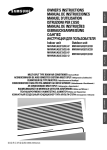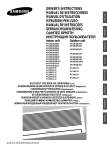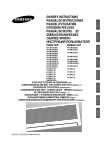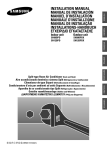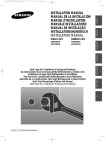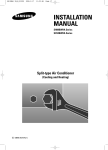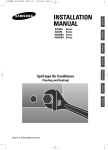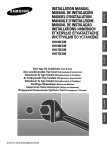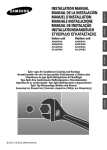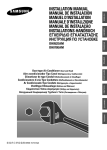Download Samsung MH14VA1(A2)(C1)(C2)X Installation manual
Transcript
Indoor unit Outdoor unit MH14VA1(A2)(C1)(C2)-07 MH18VA1(A2)(C1)(C2)-09 MH19VA1(A2)(C1)(C2)-07 MH19VA1(A2)(C1)(C2)-12 MH14VA1(A2)(C1)(C2)X MH18VA1(A2)(C1)(C2)X ENGLISH ESPAÑOL FRANÇAIS INSTALLATION MANUAL MANUAL DE INSTALACIÓN MANUEL D’INSTALLATION MANUALE D’INSTALLZIONE MANUAL DE INSTALAÇÃO INSTALLATIONS-HANDBUCH E°XEIPI¢IO E°KATA™TA™H™ àçëíêìäñàü èé ìëíÄçéÇäÖ DEUTSCH RUSSIAN E§§HNIKA MULTI-SPLIT TYPE ROOM AIR CONDITIONER ( Cool and Heat ) ACONDICIONADOR DE AIRE DOMÉSTICO SISTEMA MULTI SPLIT ( Refrigeración y Calefacción ) CLIMATISEUR DE TYPE MULTIPLE ( Refroidissement et Chauffage ) CONDIZIONATORE D’ARIA PER PIÙ AMBIENTI AD UNITÀ SEPARATE ( Raffreddamento e Riscaldamento ) AR CONDICIONADO MULTI SPLIT ( Refrigeração e Aquecimento ) RAUMKLIMAGERÄT IN MEHRFACH GETEILTER AUSFÜHRUNG ( Kühlen und Wärmen ) ¶O§Y¢IAIPOYMENO K§IMATI™TIKO ¢øMATIOY(æ‡Í˘ Î·È £¤ÚÌ·ÓÛ˘ ) äéåçÄíçõâ ÇéáÑìòçõâ äéçÑàñàéçÖê íàèÄ åìãúíà-ëèãàí (éı·ʉÂÌËÂ Ë é·Ó„‚) PORTUGUÊS ITALIANO MH19VA1(A2)(C1)(C2)X E S F I P D G R DB98-05694A(3) E-2 ENGLISH Contents ◆ PREPARING THE INSTALLATION ■ Deciding on Where to Install the Air Conditioner .......................................... ■ Air Conditioner and Accessories ................................................................... 4 6 ◆ INSTALLING THE INDOOR UNIT ■ Fixing the Installation Plate ........................................................................... ■ Purging the Unit............................................................................................. ■ Connecting the Assembly Cable ................................................................... ■ Installing and Connecting the Indoor Unit Drain Hose.................................. ■ Installing and Connecting the Indoor Unit Assembly Piping ......................... ■ Cutting/Extending the Piping ........................................................................ 7 8 8 9 10 11 ◆ INSTALLING THE OUTDOOR UNIT ■ Connecting the Cables to the Outdoor Unit .................................................. ■ Checking Correct Earthing ............................................................................ ■ Installing and Connecting the Outdoor Unit Drain Hose ............................... ■ Fixing the Unit in Position ............................................................................ 12 14 15 15 ◆ COMPLETING THE INSTALLATION ■ Connecting Up and Purging the Circuit......................................................... ■ Refrigerant Refill............................................................................................ ■ Performing Leak Tests................................................................................... ■ Placing the Indoor Unit in Position ................................................................ ■ Checking and Testing Operations ................................................................. ■ Explaining Operations to the Owner ............................................................. 16 16 17 17 18 20 ◆ TECHNICAL SPECIFICATIONS E-3 PREPARING THE INSTALLATION Deciding on Where to Install the Air Conditioner When deciding on the location of the air conditioner with the owner, the following restrictions must be taken into account. General Do NOT install the air conditioner in a location where it will come into contact with the following elements: ◆ Combustible gases ◆ Saline air ◆ Machine oil ◆ Sulphide gas ◆ Special environmental conditions If you must install the unit in such conditions, first consult your dealer. Indoor Unit ◆ There must be no obstacles near the air inlet and outlet. ◆ Install the indoor unit on a surface that can support its weight. ◆ Choose a position that enables the piping and cables to be easily connected to the outdoor unit and the recommended length of 5 metres to be respected. ◆ Leave enough clearance beneath the indoor unit to enable the filters to be removed without hindrance. ◆ Maintain sufficient clearance around the indoor unit, as indicated in the diagram on the page opposite. ◆ Make sure that the water dripping from the drain hose runs away correctly and safely. Outdoor Unit ◆ The outdoor unit must NEVER be placed on its side or upside down, as the compressor lubrication oil will run into the cooling circuit and seriously damage the unit. ◆ Choose a location that is dry and sunny, but not exposed to direct sunlight or strong winds. ◆ Do not block any passageways or thoroughfares. ◆ Choose a location where the noise of the air conditioner when running and the discharged air do not disturb any neighbours. ◆ Choose a position that enables the piping and cables to be easily connected to the indoor unit and the recommended length of 5 metres to be respected. ◆ Install the outdoor unit on a flat, stable surface that can support its weight and does not generate any unnecessary noise and vibration. ◆ Position the outdoor unit so that the air flow is directed towards the outside, as indicated by the arrows on the top of the unit. ◆ Maintain sufficient clearance around the outdoor unit, as indicated in the diagram on the page opposite. ◆ If the outdoor unit is installed at a height, ensure that its base is firmly fixed in position; the maximum height is 7 metres. ◆ Make sure that the water dripping from the drain hose runs away correctly and safely. CAUTION ◆ You have just purchased a multi-split type room air conditioner and it has been installed by your installation specialist. ◆ This device must be installed according to the national electrical rules. E-4 ◗ 14,000Btu/h Indoor unit ◗ 18,000Btu/h Outdoor unit MH14VA1(A2)(C1)(C2) MH14VA1(A2)(C1)(C2)X Power supply Ø, V, Hz 1,220-240~,50 Indoor unit ENGLISH PREPARING THE INSTALLATION ◗ 19,000Btu/h Power supply Ø, V, Hz Outdoor unit MH18VA1(A2)(C1)(C2) MH18VA1(A2)(C1)(C2)X 1,220-240~,50 Indoor unit Outdoor unit MH19VA1(A2)(C1)(C2) MH19VA1(A2)(C1)(C2)X Power supply Ø, V, Hz 1,220-240~,50 ◗ 14,000Btu/h 18,000Btu/h B-unit 9,000(2.63kW) or 12,000Btu/h(3.51kW) Pipe size Unit Gas Liquid A-Unit 1/4” 3/8” B-Unit 1/4” 3/8” 20 mm or more 100 mm or more ◗ 19,000Btu/h A-unit 7,000(2.05kW) or 9,000 Btu/h(2.63kW) (D) 160 mm or more Pipe size Unit Liquid Gas A-Unit 1/4” 3/8” B-Unit 1/4” 1/2” (B) 600 mm minimum (A) 300 mm minimum 300 mm minimum 600 mm minimum (C) A B Circuit breaker (20A) Main power switch ❋ The designs of the unit and the connection valve are subject to change according to the model. ◗ Piping length and the height Demension Composition 1 Room max length 20 m (A) or (B) 2 Room total max Max height between length indoor unit & outdoor unit 30 m 7m (A) + (B) (C) Max height between indoor unit A & B 3m (D) ◗ Chargeless 2 Room total max length Within 30m (A) + (B) 1 Room max length Within 20m (A) or (B) E-5 PREPARING THE INSTALLATION Air Conditioner and Accessories The following accessories are supplied with the air conditioner. Accessories in the Indoor Unit Case Installation Plate Remote Control Batteries for Remote Control Accessories in the Outdoor Unit Case Drain Plug Owner’s Instruction Booklet Rubber Leg Installation Manual TIONS OWNER'S INSTRUC CIONES MANUAL DE INSTRUC L'USO ISTRUZIONI PER ÕES MANUAL DE INSTRUÇ TION MANUEL D'UTILISA EISUNG GEBRAUCHSANW TIONS OWNER'S INSTRUC CIONES MANUAL DE INSTRUC L'USO ISTRUZIONI PER ÕES MANUAL DE INSTRUÇ TION MANUEL D'UTILISA EISUNG GEBRAUCHSANW Air ConditionerSplit Splut-type Room doméstico sistema ad unità Separate Aire acondicionado d'aria per ambienti Condizionatorede ar condicionado tipo Split Aparelho type séparé Climatiseur de Geteilte raumklimaanlage Air ConditionerSplit Splut-type Room doméstico sistema ad unità Separate Aire acondicionado d'aria per ambienti Condizionatorede ar condicionado tipo Split Aparelho type séparé Climatiseur de Geteilte raumklimaanlage 3-wire Power Cable (option) ➢ Flare Nuts, 6.35mm outer pipe diameter 4-wire Assembly Cable (option) Flare Nuts, 9.52mm outer pipe diameter Flare Nuts, 12.70mm outer pipe diameter The 3-wire power cable and the 4-wire assembly cable are optional. If these cables are not supplied, use the standard cable approved by IEC standard. The specification for cables AWG Cross sectional area (mm2) Three-wire power cable 14 or more 2.0 or more Four-wire assemble cable 17 or more 1.0 or more ➢ The flare nuts are only included when the air conditioner is supplied without the assembly piping illustrated below. ➢ The drain plug is supplied for heat pump model to drain the water condensed in the outdoor heat exchanger. (for installation, see page 15) The following connection accessories may be supplied, depending on the option. If they are not supplied, it is recommended that you collect them together before starting to install the air conditioner. Assembly Piping, Ø6.35mm by 5m Pipe Clamps A ➢ E-6 Assembly Piping, Ø9.52mm by 5m Pipe Clamps B Assembly Piping, Ø12.70mm by 5m M3.8 x 20 Screws for Wood PE T3 Foam Tube Insulation M4 x 16 Tapped Screws Vinyl Tape, Width 50mm Drain Hose, length 2m If these accessories are supplied, they are located in the accessory box. Putty 100g INSTALLING THE INDOOR UNIT ENGLISH Fixing the Installation Plate Before fixing the installation plate to a wall or window frame, you must determine the position of the 65 mm hole through which the cable, piping and hose pass to connect the indoor unit up to the outdoor unit. When facing the air conditioner in position on the wall, the piping and cable can be connected from the: ◆ Right ◆ Left ◆ Rear (right or left) Then follow Steps... Wall 3. Window frame 4 to 6. Fix the installation plate to the wall in a manner appropriate to the weight of the indoor unit. ➢ If you are mounting the plate on a concrete wall with anchor bolts, the anchor bolts must not project by more than 20 mm. 4 Determine the positions of the wooden uprights to be attached to the window frame. 5 Attach the wooden uprights to the window frame in a manner appropriate to the weight of the indoor unit. 6 Using tapped screws, attach the installation plate to the wooden uprights, as illustrated in the last figure opposite. Pipe hole (Ø65mm) (Unit : mm) 252 275 30 3 If you are fixing the indoor unit to a... Installation plate 30mm 2 Determine the position of the pipe and drain hose hole using the right figure and drill the hole with an inner diameter of 65 mm so that it slants slightly downwards. 60 1 90 140 410~730 (Unit : mm) E-7 INSTALLING THE INDOOR UNIT Purging the Unit On delivery, the indoor unit is loaded with an inert gas. All this gas must therefore be purged before connecting the assembly piping. To purge the inert gas, proceed as follows. Unscrew the caps at the end of each pipe. Result: All inert gas escapes from the indoor unit. ➢ To prevent dirt or foreign objects from getting into the pipes during installation, do NOT remove the caps completely until you are ready to connect the piping. Connecting the Assembly Cable The indoor unit is powered from the outdoor unit via the assembly cable. Indoor unit 1 Extend the assembly cable if necessary. 2 Open the front grille by pulling on the tabs on the lower right and left sides of the indoor unit. 3 Remove the screw securing the connector cover. 4 Pass the assembly cable through the rear of the indoor unit and connect the assembly cable such as figure. Earth terminal E ➢ Each wire is labelled with the corresponding terminal number. 5 Pass the other end of the cable through the 65 mm hole in the wall. 6 Replace the connector cover, carefully tightening the screw. 7 Close the front grille. 8 For further details on how to plug the other end of the assembly cable into the outdoor unit, refer to pages 12 and 13. E Outdoor unit E-8 Earth terminal INSTALLING THE INDOOR UNIT ENGLISH Installing and Connecting the Indoor Unit Drain Hose Care must be taken when installing the drain hose for the indoor unit to ensure that any condensation water is correctly drained outside. When passing the drain hose through the 65 mm hole drilled in the wall, check that none of the following situations occur. 5 cm less The hose must NOT slope upwards. The end of the drain hose must NOT be placed in water. Do NOT bend the hose in different directions. Keep a clearance of at least 5 cm between the end of the hose and the ground. Ditch Do NOT place the end of the drain hose in a hollow. To install the drain hose, proceed as follows. 1 If necessary, connect the 2-metre extension to the drain hose. 2 If you are using the extension, insulate the inside part of the extension drain hose with a shield. 3 Pass the drain hose under the refrigerant piping, taking care to keep the drain hose tight. 4 Pass the drain hose through the hole in the wall, making sure that it is sloping downwards, as shown in the illustrations above. ➢ Shield Drain hose Extension drain hose The hose will be fixed permanently into position once the whole installation has been tested for gas leaks; refer to page 17 for further details. E-9 INSTALLING THE INDOOR UNIT Installing and Connecting the Indoor Unit Assembly Piping There are two refrigerant pipes of different diameters: ◆ A smaller one for the liquid refrigerant ◆ A larger one for the gas refrigerant A short length of piping is already fitted to the air conditioner. You must extend this piping using assembly piping (optionally supplied). The connection procedure for the refrigerant piping varies according to the exit position of the piping from the indoor unit, as seen when facing the air conditioner in position on the wall: ◆ Right (A) ◆ Left (B) ◆ Rear B A 1 With a knife, cut out the appropriate knock-out piece on the rear of the indoor unit (unless you are connecting directly from the rear). 2 Smooth the cut edges. 3 Remove the protection caps on the pipes and connect the assembly piping to each pipe, tightening the nuts, first manually and then with a wrench, applying the following torque. Pipe Liquid refrigerant Gas refrigerant Gas refrigerant Outer Diameter 6.35 mm 9.52 mm 12.70 mm Torque (kg•cm) 160 300 500 ➢ If the piping must be shortened or extended, refer to page 11. 4 Cut off any excess foam insulation. 5 If necessary, bend the pipe round, along the bottom of the indoor unit and out through the appropriate hole, taking care to ensure that: ◆ The piping does not jut out from the rear of the indoor unit ◆ The bending radius is 100 mm or more 6 Pass the piping through the hole in the wall. 7 For further details on how to connect up to the outdoor unit and purge the circuit, refer to page 16. ➢ The piping will be insulated and fixed permanently into position once the whole installation has been tested for gas leaks; refer to page 17 for further details. E-10 INSTALLING THE INDOOR UNIT ENGLISH Cutting/Extending the Piping Five metres of piping is supplied with the air conditioner(Optional). This length can if necessary be: ◆ Extended to a maximum length ◆ Shortened as required ☛ If more than five metres of piping is required: ◆ The assembly cable must also be extended ◆ Refrigerant must be added to the circuit by an approved installer; otherwise, the indoor unit may freeze 1 Make sure that you have the required tools available (pipe cutter, reamer, flaring tool and pipe holder). 2 If you wish to shorten the piping, cut it using a pipe cutter, taking care to ensure that the cut edge remains at a 90° angle with the side of the pipe, and referring to the illustrations below for examples of edges cut correctly and incorrectly. Oblique Rough Burr 90 O O x x x 3 To prevent any gas from leaking out, remove all burrs at the cut end of the pipe, using a reamer. 4 Slide a flare nut on to the pipe and modify the flare. Pipe Liquid refrigerant Gas refrigerant Gas refrigerant 5 6 Depth (A) 1.3 mm 1.8 mm 2.0 mm Check that the flaring is correct, referring to the illustrations below for examples of incorrect flaring. x x x x Inclined Damaged Surface Cracked Uneven Thickness Align the pipes to be connected and tighten the flare nuts first manually and then with a wrench, applying the following torque. Pipe Liquid refrigerant Gas refrigerant Gas refrigerant 7 Outer Diameter (D) 6.35 mm 9.52 mm 12.70 mm Outer Diameter 6.35 mm 9.52 mm 12.70 mm Torque (kg•cm) 160 300 500 For further details on how to connect up to the outdoor unit and purge the circuit, refer to page 16. E-11 INSTALLING THE OUTDOOR UNIT Connecting the Cables to the Outdoor Unit Two electric cables must be connected to the outdoor unit: ◆ The assembly cable connecting the indoor unit to the outdoor unit. ◆ The power cable connecting the auxiliary circuit breaker to the outdoor unit. MH14VA1(A2)(C1)(C2)X 1 Remove the terminal board cover on the side of the outdoor unit. 2 Connect the assembly cable with the power cable such as figure. ➢ ➢ MH18VA1(A2)(C1)(C2)X MH19VA1(A2)(C1)(C2)X 3 Each wire is labelled with the corresponding terminal number. Ensure the wire number of the indoor unit and the terminal number of the outdoor unit. Connect the earth wires to the earth terminals. ➢ Refer to the page 14 for further details on how to check that earthing is correct. E-12 4 Replace the terminal board cover, carefully tightening the screw. 5 Connect the power cable to the auxiliary circuit breaker. ENGLISH INSTALLING THE OUTDOOR UNIT Outdoor unit (N1) 1 2 (N1) 1 2 N L N L Terminal block E Earth terminal Circuit Breaker (Main Power supply cable) (N1) 1 2 E Earth terminal (N1) 1 2 E Earth terminal Assembly cable (N1) 1 2 Indoor unit (N1) 1 2 A-unit E Earth terminal 1 2 (N1) 1 2 (N1) E Earth terminal B-unit E-13 INSTALLING THE OUTDOOR UNIT Checking Correct Earthing If the power distribution circuit does not have an earth or the earth does not comply with specifications, an earthing electrode must be installed. The corresponding accessories are not supplied with the air conditioner. Carbon plastic 1 Select an earthing electrode that complies with the specifications given in the illustration opposite. 2 Determine a suitable location for the earthing electrode: ◆ In damp hard soil rather than loose sandy or gravel soil that has a higher earthing resistance ◆ Away from underground structures or facilities, such as gas pipes, water pipes, telephone lines and underground cables ◆ At least two metres away from a lightening conductor earthing electrode and its cable Steel core PVC-insulated green/ yellow wire, 2mm2 x 3.5 m To earthing screw ➢ 3 Dig a hole of the size indicated in the illustration opposite, drive the earthing electrode into position and cover the top of the electrode with the excavated soil. 4 Install a green/yellow insulated earthing wire (Ø1.6 mm, section 2 mm2 or greater): ◆ If the earthing wire is too short, connect an extension lead, soldering the connection and wrapping it with insulating tape (do not bury the soldered connection) ◆ Secure the earthing wire in position with staples 30 cm 50 cm The earthing wire for the telephone line cannot be used to earth the air conditioner. ➢ If the earthing electrode is installed in an area of heavy traffic, its wire must be connected securely. E-14 5 Carefully check the installation, by measuring the earthing resistance with an earthing resistance tester. If the resistance is above the required level, drive the earthing electrode deeper into the ground or increase the number of earthing electrodes. 6 Connect the earthing wire to the earthing screw on the air conditioner. INSTALLING THE OUTDOOR UNIT ENGLISH Installing and Connecting the Outdoor Unit Drain Hose When using the air conditioner in the heating mode, ice may accumulate. During de-icing, the condensed water must be drained off safely. Consequently, you must install a drain hose on the outdoor unit, following the instructions below. 1 Insert the drain plug into the drain hole on the underside of the outdoor unit. 2 Connect the drain hose to the drain plug. 3 Ensure that the drained water runs off correctly and safely. Drain hole ❊ The designs and shape are subject to change according to the model. Fixing the Unit in Position The outdoor unit must be installed on a rigid and stable base to avoid any increase in the noise level and vibration, particularly if the outdoor unit is to be installed close to a neighbour. 1 Position the outdoor unit so that the air flow is directed towards the outside, as indicated by the arrows on the top of the unit. 2 Attach the outdoor unit to the appropriate support using anchor bolts. 3 If the outdoor unit is exposed to strong winds, install shield plates around the outdoor unit, so that the fan can operate correctly. “Y”mm If it is to be installed in a location exposed to strong winds or at a height, the unit must be fixed to an appropriate support (wall or ground). “X”mm Rubber leg Model X Y ✴✴14✴✴ 555 295 ✴✴18/19✴✴ 582 340 ❇ Certainly fix up its rubber leg, in order to prevent its vibration and noise. E-15 COMPLETING THE INSTALLATION Connecting Up and Purging the Circuit CAUTION The air in the indoor unit and in the pipe must be purged. If air remains in the refrigeration pipes, it will affect the compressor, reduce to cooling/heating capacity and could lead to a malfunction. Refrigerant for air purging is not charged in the outdoor unit. Use Vacuum Pump as shown at the right figure. Each unit must be purged in turn. A Indoor A-unit Indoor B-unit 1 Check the piping connections. 2 Connect the charging hose of low pressure side of manifold gauge to the packed valve having a service port (3/8” or 1/2” Packed valve) as shown at the right figure. 3 Open the valve of the low pressure side of manifold gauge counterclockwise. 4 Purge the air from the system using vacuum pump for about 10 minutes. - Close the valve of the low pressure side of manifold gauge clockwise. - Make sure that pressure gauge show -0.1MPa(-76cmHg) after about 10minutes. This procedure is very important in order to avoid gas leak. - Turn off the vacuum pump - Remove the hose of the low pressure side of manifold gauge. 5 Set valve cork of both liquid side and gas side of packed valve to the open position. 6 Mount the valve stem nuts and the service port cap to the valve, and tighten them at the torque of 18N•m with a torque wrench. 7 Check for gas leakage. - At this time, especially check for gas leakage from the 3-way valve’s stem nuts, and from the service port cap. B Vacuum Pump ❊ The designs and shape are subject to change according to the model. Liquid side Valve stem Stem cap Gas side Service port Refrigerant Refill If total pipe length(A+B room) is more than 30 metres, additional refrigerant should be charged by extra metre. You don't have to charge additional refrigerant up to total 30 metres of connecting pipe. E-16 1 Remove the valve stem cap and service port of 3-way valve. 2 Connect the charging hose of low pressure side of manifold gauge to the packed valve having a charging port (3/8” or 1/2” Packed valve). 3 Operate the unit at the cooling mode. 4 Slowly open the valve of the low pressure side of manifold gauge counterclockwise until the low pressure of manifold gauge indicates 4.3 to 4.8kg/cm2 at the high cool operation (2-unit operation) and the standard temperature of indoor 27°C and outdoor 35°C. It is recommend that refrigerant should be slowly put in. If the refrigerant is put in too quickly, compressor will be damaged. 5 Stop operation of the air conditioner. 6 Disconnect the charge hose of manifold gauge. 7 Close the cap of each valve. COMPLETING THE INSTALLATION ENGLISH Performing Leak Tests Before completing the installation (insulation of the cables, hose and piping and fixing of the indoor unit to the installation plate), you must check that there are no gas leaks. To check for gas leaks on the... Then, using a leak detector, check the... Indoor unit Flare nuts at the end of sections C and D. Outdoor unit Valves on sections A and B. C D B A ❊ The designs and shape are subject to change according to the model. Placing the Indoor Unit in Position Once you have checked that there are no leaks in the system, you can insulate the piping, hose and cables and place the indoor unit on the installation plate. 1 To avoid condensation problems, place heat-resistant polyethylene foam separately around each refrigerant pipe in the lower part of the indoor unit. 2 Wind insulating tape around the pipes, assembly cable and drain hose. 3 Place the resulting bundle carefully in the lower part of the indoor unit, making sure that it does not jut out from the rear of the indoor unit. 4 Hook the indoor unit on to the installation plate and move the unit to the right and left until you are sure that it is securely in place. 5 Finish wrapping vinyl tape around the rest of the piping leading to the outdoor unit. 6 Using clamps (optionally supplied), attach the piping to the wall wherever possible. Installation plate E-17 COMPLETING THE INSTALLATION Checking and Testing Operations To complete the installation, perform the following checks and tests to ensure that the air conditioner is operating correctly. Step 1 Review all the following elements in the installation: INDOOR UNIT Room select switch ◆ Installation site strength ◆ Piping connection tightness to detect any gas leakages ◆ Connection wiring ◆ Heat-resistant insulation of the piping ◆ Drainage ◆ Earthing wire connection Step 2 ◆ B unit A unit ◆ Check the room select switch in the indoor unit: Move the room select switch downward in the A unit and move the switch upward in the B unit. Set an indoor unit connected to upper service valves to the A unit, then set the other indoor unit connected to lower service valves to the B unit. The liquid and gas refrigerant pipes should not be crossed with each other. Step 3 Apply the power to the outdoor unit. OUTDOOR UNIT A unit B unit E-18 ENGLISH COMPLETING THE INSTALLATION If the indicators display an error, check the following items. ◆ Room select switch - Check that you have set the switch to the proper position. ◆ Quantity of refrigerant - The error can be occurred when the refrigerant is insufficient. ◆ Connection of refrigerant pipes - Upper service valves on the outdoor unit are for the A unit and the others (lower service valves) are for the B unit. - Refrigerant pipe should not be crossed with each other. E-19 COMPLETING THE INSTALLATION Explaining Operations to the Owner Before leaving the premises on which you have installed the air conditioner, you should explain the following operations to the owner, making reference to the appropriate pages in the owner’s instruction booklet. 1 How to start and stop the air conditioner. 2 How to select the operating mode and adjust the temperature and fan settings. 3 How to adjust the air flow direction. 4 How to set the timers. 5 How to remove and clean the filters. Once the owner is happy with the basic operations, hand over the owner’s instruction booklet and this installation manual for storage in a handy and safe place. E-20 TECHNICAL SPECIFICATIONS ENGLISH Technical Specifications Model Indoor unit Model Outdoor unit MH14VA1(A2)(C1)(C2)-07 MH14VA1(A2)(C1)(C2)X MH18VA1(A2)(C1)(C2)-09 MH18VA1(A2)(C1)(C2)X MH19VA1(A2)(C1)(C2)-07 MH19VA1(A2)(C1)(C2)-12 MH19VA1(A2)(C1)(C2)X Power Supply 220-240V~, 50Hz E-21 THIS AIR CONDITIONER IS MANUFACTURED BY: ESTE AIRE ACONDICIONADO HA SIDO FABRICADO POR: CE CLIMATISEUR EST FABRIQUE PAR: QUESTO CONDIZIONATORE D’ARIA È PRODOTTO DA: ESTE APARELHO DE AR CONDICIONADO É FABRICADO POR: DIESE KLIMAANLAGE IST FABRIZIERT VON: AYTH H ™Y™KEYH KATA™KEYA™THKE A¶O: ùíéí äéçÑàñàéçÖê àáÉéíéÇãÖç îàêåéâ: ELECTRONICS Printed in Korea























